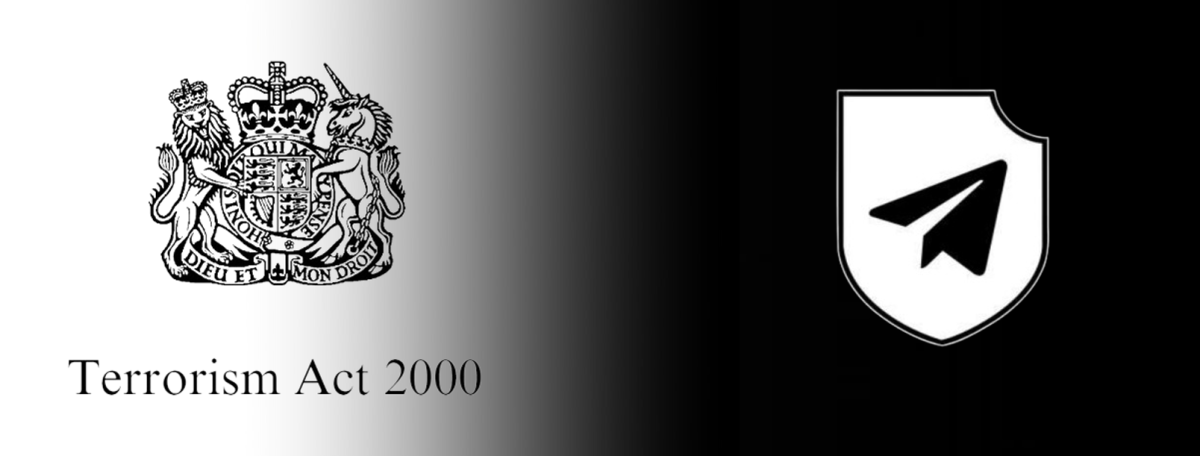On 26 April the UK became the first country in the world to proscribe the ‘Terrorgram Collective’. From today, membership, support, or the display of articles associated with the network is now illegal and can carry a punishment of up to 14 years in prison or an unlimited fine. The listing of Terrorgram represents a novel use of the proscription power as it is the first time that an online terror network has been proscribed as a terrorist organisation in the UK under the Terrorism Act 2000. The wording of the act has been deemed sufficiently broad enough to encompass such a network, despite its “entirely fluid, online presence”.
Terrorgram is a network of neo-fascist terrorists based on the encrypted messaging app Telegram. They promote militant accelerationism, a doctrine which strives to bring about the collapse of liberal, democratic and capitalist societies, by placing pressure on and exacerbating “latent social divisions, often through violence, thus hastening societal collapse”. Terrorgram produces and disseminates violent propaganda and instructional material to encourage terrorism. This includes digital publications in the form of zines, collectively authored by individuals across the network, which stand out for their visually appealing aesthetic and graphics providing instructions for bomb-making or sabotaging critical infrastructure.
Another hallmark of Terrorgram is ‘Saints Culture’, where far-right terrorists, including the Christchurch attacker Brenton Tarrant and Oklahoma City bomber Timothy McVeigh, are glorified and worshipped as ‘Saints’ in visual propaganda. By sanctifying each new perpetrator and retroactively anointing historical white supremacist terrorists as martyrs, Terrorgram encourages the mobilisation of further attackers by community-building around the cause of ‘white terror’.
In October 2022, the first attack linked to Terrorgram took place, when Juraj Krajčík, shot and killed two and injured a third outside an LGBTQ+ bar in Bratislava, Slovakia. Krajčík addressed and thanked Terrorgram for their propaganda in his manifesto and directed readers to Terrorgram publications, praising them for “building the future of the White revolution, one publication at a time.” The Terrorgram collective responded by enthusiastically adding him to their pantheon of Saints, and anointed him as “Terrorgram’s first Saint”.
Terrorgram is the 81st group to be proscribed in the UK, and the sixth Extreme Right-Wing terrorist organisation to be listed, alongside National Action (2016), Sonnenkrieg Division and Feuerkrieg Division (2020), Atomwaffen Division/National Socialist Order and The Base (2021). The inclusion of Terrorgram showcases the ability of the proscription tool to be used against an online terrorist network and highlights how existing legislation, which has traditionally been geared towards groups and organisations, can be applied to emerging terrorist threats in a digital age to meet the challenge posed by a post-organisational terrorist landscape. I spoke to Jonathan Hall KC, the Independent Reviewer of Terrorism Legislation in the UK, about the significance of Terrorgram’s proscription:
How does the decision to proscribe an online network like the Terrorgram collective, rather than a ‘traditional’ group, reflect the evolving nature of terrorist threats in the digital age?
It strongly reflects the evolving terrorist threat in the digital age, it’s not the first predominantly online group that has been prescribed. In the UK there have been groups like Sonnenkrieg Division, Feuerkrieg Division and Atomwaffen which have a very strong online presence, but have been involved, either here or abroad, in physical acts. What is unique about Terrorgram collective is that it’s being proscribed purely because of its online content.
It reflects the nature of the threat and the risk. Online content is just becoming more and more dangerous, persuasive, and effective. It’s capable of being exploited very effectively by tech-savvy actors and there is an emerging aspect of accelerationism, which is so actor neutral. It doesn’t matter who carries out the acts. All they want to do is to inspire someone, and that can be someone anywhere in the world. As we have seen, the Terrorgram collective’s propaganda inspired that attack in Bratislava.
How has Terrorgram met the proscription criteria?
So, the really interesting one is the fact that it is assessed to be an organisation. If you look at the government’s explanatory memorandum to the draft statutory instrument, it talks about a ‘core leadership’, which directs the output. So, first of all, it qualifies as an organisation, which is a necessary aspect if it is going to be proscribed under UK law. Because only groups or organisations can be proscribed. You can’t proscribe an individual, you can’t proscribe content, you can only proscribe an organisation. So that was a really crucial assessment.
And then the criteria, there’s the single criteria of being ‘concerned in terrorism’. But that means, and there are two limbs of this, one is that it ‘promotes or encourages terrorism’, and that’s pretty self-explanatory. The interesting one here, is that it was also assessed that it ‘prepares for terrorism’, and this has a slightly extended meaning. It prepares by providing instructional material to other people. So, its helping other people prepare for their acts and that could be, for example, providing a manual on how to carry out a knife or weapons attack or how to build a 3D-printed gun or something of that nature. So, it’s assessed to actually be involved in facilitating other people’s attacks.
Do you anticipate any challenges in enforcing the proscription of an online network like Terrorgram, particularly in terms of identifying and prosecuting individuals involved in its activities?
I think it depends on the facts. The government has been able to assess there is a core leadership, so it then depends on where that core leadership is located, and whether or not there is any evidence that can be used to prosecute them. So, the primary response of proscription is to find the members and prosecute them. As I say, if they are in the UK that’s possible. If they are not in the UK, it is going to be very difficult. It depends on their operational security; it depends on whether there will be any useful evidence they are responsible for the Terrorgram collective. So, there is this question of facts, is there any evidence?
Probably, the greater dividend is the ability to say to tech companies they should remove any branded material, because this is now a UK proscribed organisation. And the fact that the UK has proscribed, is seen as a legitimate reason for removing material. It’s a step beyond the bounds of what is acceptable. So it is probably going to be used most, I mean I can’t say for sure, but as a way of disrupting its presence on the internet.
This actually brings us to my next question. What role could the proscription of online networks play in addressing the dissemination of terrorist content, such as instructional material aimed at aiding preparation for terrorism?
Obviously, most content is going to be hosted by overseas platforms. It could be on Telegram, or it could be on a standard platform like Facebook. Now, depending on their capability, whether they have the human moderators or technical capability to identify this, you would hope that those bodies would remove it. Not because they are bound by UK law, but because they sign up to a set of standards and they are prepared to accept, from a democracy like the UK, with checks and balances, the opportunity of appeal, and the fact that it is ratified by parliament, they are prepared to accept this is something that they should remove. But to some extent, it is brokered. It is not something that is demanded by the UK.
There are obviously much smaller platforms, some of whom are just very antagonistic, either because they are obsessed with free speech, or because they are just used by terrorists, who won’t comply. And there is a problem with terrorist-operated websites, there are problems with small platforms that are hosted in jurisdictions, who don’t really feel responsible for their conduct, where it is going to be really hard. In general, proscription will provide a basis for UK and intermediate organisations like the Global Internet Foundation to Counter Terrorism and Tech Against Terrorism, which are these trade bodies, to say, “you should remove this stuff”. Whether it’s going to be removed from all the platforms will depend upon a lot of things like, where they are, if it’s encrypted, what their capability is, and what their attitude is.
How do you assess the effectiveness of the UK’s proscription regime in adapting to the challenges posed by post-organisational terrorism, and do you have any recommendations for further enhancing its capabilities in this regard?
I’m impressed about how adaptable it’s proven to be. It does depend upon that ability to say, and if there is a challenge, to prove that there is central leadership. I had a look in one of my annual reports, I think my ‘Terrorism Acts in 2021’ report. I looked at the proscription tool and sort of posed the question, “what could you do when you can’t identify core organisation?” And I think the answer is, probably nothing using the proscription tool, without changing it beyond its intended use.
We don’t have a tradition in the UK of making content illegal, unlike in Germany, where it is illegal to display a swastika. We make conduct illegal. With our history of Northern Irish terrorism, we’ve focused on the conduct of groups as being the most dangerous. I think it would be very odd to proscribe an individual. If you adapted to a post-organisational world, and said “well why don’t you have the ability to ban an individual?” It would be impossible to implement. You can’t commit a crime for being you, you can commit a crime for being a member of a terrorist organisation, and you can choose to leave that terrorist organisation, which would be good, but if you were to ban an individual, well they’re always going to be that individual. The framework of membership offences wouldn’t be available. The framework of giving money to a proscribed organisation also wouldn’t work, would it? Because people are allowed to have money, to receive money from the benefits system, they are allowed to pay money in shops. The framework, which said “you shouldn’t give money to or receive money from a terrorist organisation”, wouldn’t work when applied to individuals.
And if you start banning content, first of all, it has not been our tradition, but even if it was, you would have to constantly update your database. You would have to say “we’re banning this publication, now we’re banning this publication”, which is not something you can easily keep up with. It’s something that New Zealand did in relation to the Christchurch video. And it has something that Australia has done with what they call ‘abhorrent materials’, they’ve created a special category of first-person perpetrator video. But that’s very different from the proscription methods. So I think the answer is, there is probably not much more that you can do, but it’s proven surprisingly adaptive.
Where proscription has been used against groups that operate predominantly online or have more of an online than an offline presence, it’s been a different sort of counter-terrorism campaign. Because these groups have historically just sort of disappeared quite quickly. It has proven quite effective. If you contrast that to the groups which remain of concern, like Al-Muhajiroun, al-Qaeda, but thinking more about British-based groups, like the IRA, I mean, those have endured. That probably tells you something about the original solidity of the group. Some of these internet groups will be a bit ‘here today, gone tomorrow’. And proscription will be a way of finishing them off.


